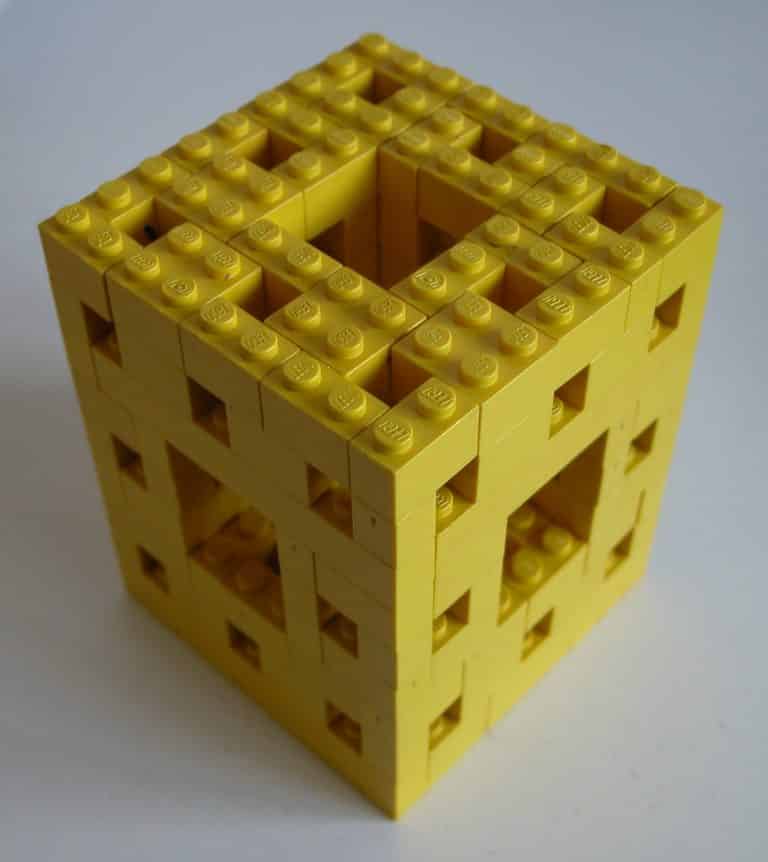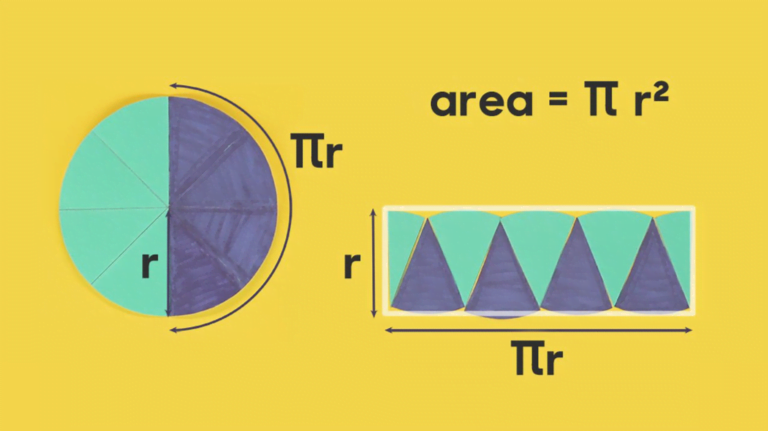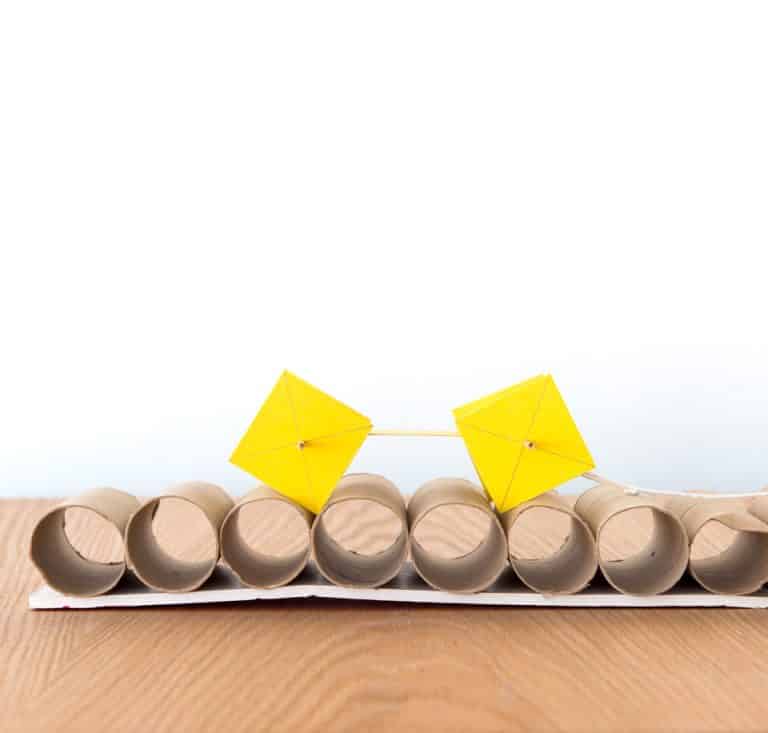How do you put a straight rod through a curved slot? If you see a straight rod and a curved slot, common sense says the rod can’t possibly fit through the slot. But if the rod is angled and rotated through space, it describes a three-dimensional shape with a hyperbolic cross section. So if the slot is the exact shape of this hyperbola, you can make the straight rod pass through it.

Ingredients:
- Wood rectangle for base, approximately 3 1/2 x 12 x 3/4 inches (9 x 30 x 2 centimeters)—exact dimensions are not critical; a convenient method is to cut a 12-in length of standard 1 x 4 pine lumber, which is 3 1/2 inches wide and 3/4 inches thick
- Two wood blocks, each 1 1/2 x 3 x 3/4 inches (4 x 7.5 x 2 cm)—exact dimensions are not critical; a convenient method is to cut 3-in long pieces of standard 1 x 2 pine lumber, which is 1 1/2 inches wide and 3/4 inches thick
- 5-in (12.5-cm) length of wooden dowel, 1/2-in diameter
- 11-in length of wooden dowel, 3/16-in diameter
- #6 flat-head wood screw, 1 1/2 in long
- Two 5-in (12.5-cm) lengths of 1/2-inch Schedule 40 PVC pipe
- 1/2-inch PVC 90-degree elbow
- Printed slot template (not shown)
- 7 x 11-in (18 x 30-cm) piece of foam core (mat board or stiff cardboard can also be used, as well as tempered hardboard (masonite) or ⅛-in acrylic plastic if you have access to a band saw or scroll saw)
- X-Acto knife or utility knife
- Drill
- Drill bits, 1/8 in and 3/16 in
- Screwdriver
- Pencil
- Ruler
- Hot-glue gun and glue
- Optional: masking tape
STEP 1
Take the wood board that will serve as a base and lightly draw a line lengthwise down the center.
STEP 2
Drill a 1/8-inch diameter hole all the way through the base, 3 inches (7.5 cm) from one end and on the centerline.
STEP 3
Drill a 1/8-inch diameter hole about 3/4 inch deep in the center of one end of the 1/2-inch dowel. Drill this hole as straight into the center of the dowel as possible.
STEP 4
Screw the 1½-inch screw through the hole in the base, from the bottom side of the base to the top side. The flat head of the screw should end up flush with the bottom side of the base so that the base doesn’t wobble. (If tightening the screw doesn’t let the head of the screw sink into the soft pine enough without stripping, you may have to “countersink” the screw by slightly enlarging the hole on the bottom with a larger drill bit, allowing the head of the screw to go far enough into the base so that the base can lie flat. Alternatively, you can add small rubber bumpers to the bottom of the base so the base is slightly elevated, thus allowing the screw head to extend slightly below the base without producing a wobble.) The pointed end of the screw should stick straight up through the top of the base. Place the hole end of the 1/2″ dowel on the point of the protruding screw and twist the dowel onto the screw until the end of the dowel is tight against the base.
STEP 5
Download and print the hyperbolic slot template. Lay the printed template on the foam core (or Masonite or other material) and align the right side of the horizontal shaded rectangle on the template with the right edge of the long (11-inch) side of the foam core. Center the template vertically along that edge. You may want to tape it in place.
STEP 6
Using the template as a guide, cut the hyperbolic slot pattern in the foam core, Masonite or other material, using an appropriate cutting tool (knife, bandsaw, scroll saw).
STEP 7
Hot glue one of the wood blocks to the base so that it is offset about 1/8 in from the centerline. Except for the 1/8 in offset, the exact position of the block along the centerline is not critical (see photo below).

STEP 8
Place the foam core on the centerline so that it is against the glued block, and then glue the second wood block on the other side to form a sandwich, with the foam core (or other material) held between the wood blocks. When the glue for both blocks has dried, you will want the foam core to be held firmly in place between the blocks but not so tightly that you can’t make small adjustments to its position.
STEP 9
Drill a 3/16-inch hole all the way through the diameter of one of the ½ inch PVC pipes, 1 in (2.5 cm) from one end.
STEP 10
Insert the 3/16 in wooden dowel through the holes until it is centered. (If the dowel doesn’t remain in place, wrap a rubber band around the upper section of the dowel and then slide the rubber band down until it is up against the PVC at the hole or use a little glue to hold the dowel in place.)
STEP 11
Attach the other end of this PVC pipe to one end of the 90-degree PVC elbow. Attach the second PVC pipe to the other end of the elbow.

STEP 12
Slip the open end of the second PVC pipe over the 1/2-inch dowel protruding from the base.
STEP 13
Use the 3/16-in dowel as a handle to gently rotate the upper PVC pipe until the 3/16-in dowel is close to a 45-degree angle with the horizontal.
STEP 14
Adjust the position of the foam core and the orientation of the 3/16-in dowel arm so the dowel arm can pass smoothly through the slot as the arm assembly is rotated. The adjustment may require some patience and tinkering. If absolutely necessary, you may consider modifying the size of the slot, or cutting some material off the bottom of the foam core.
STEP 15
Rotate the arm assembly, and observe the straight rod passing smoothly through the slot. Try to focus your attention on the shape that the rod sweeps out in space as it rotates.
As the rod swings around it sweeps out a three-dimensional shape called a hyperboloid. A two-dimensional cross section of the hyperboloid is a shape called a hyperbola. The rod passes through the slot cut into the foam core because the slot has the same hyperbolic shape as the cross-section of the hyperboloid made by the rotating rod.








